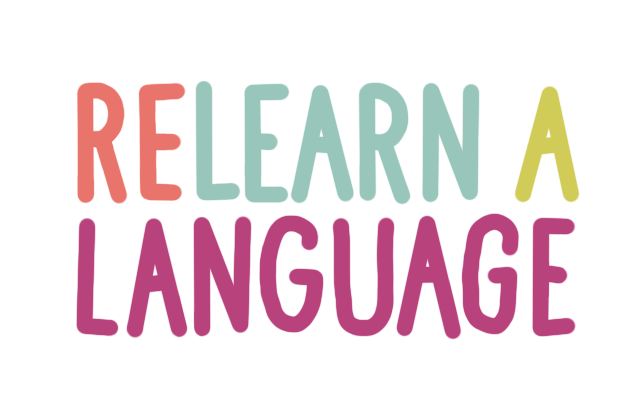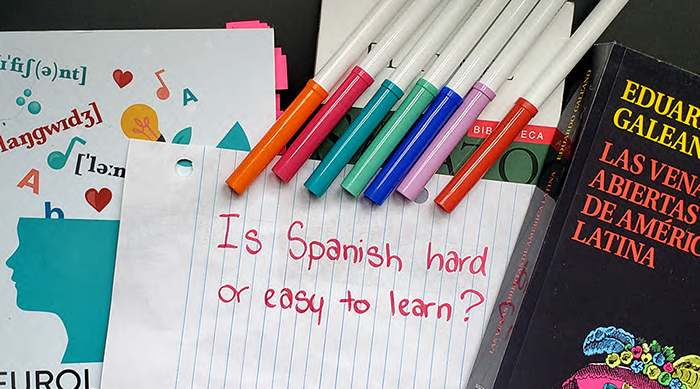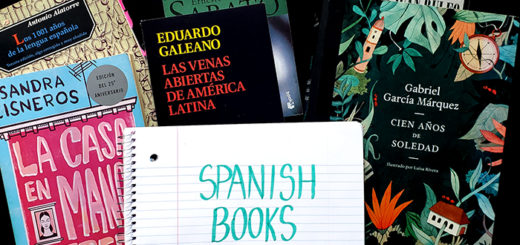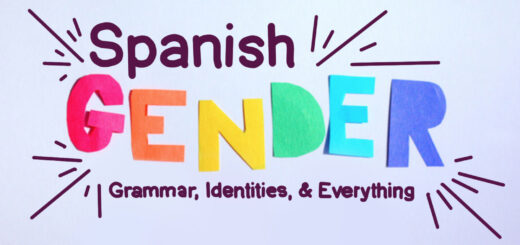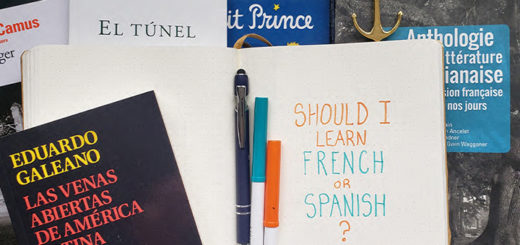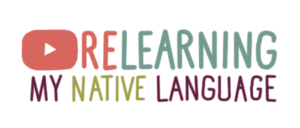Is Spanish Hard To Learn?
With the growing use of Spanish in the US and Canada, more and more English speakers have begun to ask themselves: is Spanish easy to learn? Or is Spanish hard to learn?
The deciding factor for if Spanish is hard or easy to learn may be with you–the learner–more than with the language itself.
But if you’re considering beginning to learn Spanish (or relearn it), we have a great quiz for how long does it take to speak Spanish.
By the end of this article, you’ll know (1) more about what external factors make Spanish hard or easy to learn (2) what you can do to make Spanish easier to learn for yourself and (3) what makes Spanish as a language a bit easier than other types of languages.
I’ll illustrate it with tons of interesting examples, and you’ll learn a bunch about languages.
Let’s dive into Spanish grammar, vocabulary, tools, common problems, and more!
This article is part of a larger series called French vs Spanish. Click the title to see the main article, or click here to see all French vs Spanish articles.
Why Spanish might seem hard to learn

I failed out of high school Spanish, now I learn languages (and blog about them) as a hobby. Let’s investigate if learning Spanish is hard together.
Starting a language can seem like a daunting project, especially if you live in a monolingual bubble.
(If you’re new to languages, the term monolingual refers to one (mono) tongued (lingual). And if you’ve lived surrounded entirely by English your whole life, a new language might seem like another world.)
So let’s look at why some people might be wondering if Spanish is hard to learn.
Past failures
English speaking school systems are notoriously known for producing monolingual children despite years of language training.
- In the US, only 20% of Americans ever study a new language. And there are no statistics on how many of that 20% can actually communicate the language they study.
- Despite the British Isles being the home of 7 home-grown languages, (not even counting Manx or the three recognized sign languages), 62% of British citizens only speak English.
- And Australia? 73% of the nation speaks only English at home. 250 indigenous languages are believed to have existed when Europeans first conquered the island.
- In legally bilingual Canada, only 24% of Canadians can speak both of the country’s national languages despite all Canadians having to take English and French in public schools.
This must be because languages are super hard right?
So is Spanish hard to learn and we should just give up reading here?
Not at all.
- In the island nation of Malta, on top of their own Maltese language, 88% of the population speak English, another 66% Italian, and 17% can speak French. Their public schools also offer Arabic, German, Russian, and Spanish as additional languages.
- Switzerland has 4 federal languages (French, German, Italian, and Romansh). 64% of Swiss citizens say they use more than one language on a weekly basis, 38% use two or more languages once a week, 19% use three or more, and 7% say they use 4 or more languages every week. [source]
- And countries like Germany, Poland, or France that only recognize one language as their national language? (Even if many more are spoken there?) As far as English goes, 56% of Germans, 34% of Poles, and 39% of the French say they can hold a conversation in English. (Which, of course, doesn’t count how many of them may also speak Italian, Russian, or any other language.)
So what does this have to do with Spanish being hard or easy to learn?
Let’s be clear:
If you failed to learn Spanish, French, or any language in school, it’s not your fault.
You’re not bad at languages. You’re not stupid.
It was your school.
So what’s the difference between English-speaking schools and those in countries like Malta or Switzerland?
Well, it’s more than just schools.
Monolingual societies
For citizens who live in societies where only one language is promoted (even if many others are spoken there), learning a second language can be difficult.
But it’s not the difficulty of having a second language.
It’s the culture they’re living in.
So why is that?
Languages are undervalued
 How could a country’s opinions about languages affect your personal ability to study Spanish? Let’s look.
How could a country’s opinions about languages affect your personal ability to study Spanish? Let’s look.
First, a question. How many Americans think French is a beautiful language? With 76 million speakers, the language of love has been long beloved by Americans, even right down to their accents. There are even entire books about why Americans love France and all things French.
And our college language choices are a reflection of that. 198,000 college students were enrolled in French courses in 2016.
“But that makes sense!” cries the reader. “We don’t hate languages at all!”
Well, it’s a bit more complicated than that.
What do Americans think about Bengali?
Think for a moment: how many speakers do you think Bengali has?
Do you know where it’s spoken?
Is it a country, a city, a region, or what?
And what do you think about it when you hear the name?
Bengali has 230 million native speakers–about three times the number of native French speakers. Bangladesh is one of the top 30 largest economies of the world, and has the EIGTH largest population in the world at 168 million people! (France itself has only 67 million people.)
But 7 students through the US were studying Bengali that same year that 198,000 were studying French.
The languages we learn or don’t learn are based entirely on what our society thinks about those languages.
And if popular perception changes which languages we learn… can it affect our attitudes about language learning as well?
Could it even affect if we perceive languages as hard or easy to learn?
Let’s go into how social attitudes directly affect language classrooms.
Language education is underfunded
In a nutshell, popular attitudes can quickly turn into economic and educational disasters.
81% of Americans in a 2016 Pew study reported that speaking English was “very important”, but only 36% thought learning a “foreign language” was “important”.
So what else was happening the same year?
Between 2013-2016, 651 language programs were cut across the US according to the Modern Languages Association of the US. Even America’s favorite language, French, wasn’t spared. It lost 129 programs in the blow.
Does all this mean that a language is hard to learn if you live in an English-speaking country?
Well, the odds are certainly stacked against you in school.
But it doesn’t just end there.
Fewer language learners = fewer language resources
Let’s get back to the example of the country of Malta, where the overwhelming majority of its citizens are bilingual or multilingual.
Malta has 2 official languages, Maltese and English, and previously had Italian as an official language.
How does this factor into the Maltese people becoming well-known for their multilingualism?
- Only 82.41% of the population regularly listens to Maltese radio. 25.41% listens to Italian and a smaller 14.69% listens to English radio. [Source]
- Local TV in Malta in bilingual between Maltese and English. [Source]
- There are equal numbers of national newspapers in Maltese and English. [Source]
- 3% of Maltese prefer to read books in Italian than in other languages, and 6% said that about Italian language magazines. [Source]
Now can you imagine all TV channels, major newspapers, and radio stations suddenly turning bilingual in English speaking countries?
Probably not.
Little language learning creates little demand for language exposure, which in turn creates little language learning and well… you get the picture.
So now let’s start applying this all to if Spanish is hard or easy to learn.
Citizens of multilingual countries are constantly surrounded by other languages.
So let’s recap the differences between monolingual countries and multilingual countries:
- Multilingual countries have better funding for public language programs
- Multilingual countries create “at home immersion” environments for their citizens
- Multilingual countries have more multilingual people to speak various languages with
- Multilingual countries experience less violence or stigma towards bilingual people
So does that mean if you’re in a monolingual country, learning a second language is impossibly hard?
Not at all.
It just means there are a lot of big, powerful, and rich forces trying to scare you away from learning Spanish.
But that shouldn’t scare you at all.
There are plenty of polyglots and multilingual people who have put a ton of amazing language learning resources online, or who have created blogs like this one to help you out.
By the end of this article, you’ll have a better path forward for learning Spanish and understand what you can do to make it easier to learn.
Now that we’ve gone through why Spanish might seem hard to learn, let’s look at the Spanish language itself and talk about your individual situation.
Is Spanish vocabulary hard to learn?
What makes a word hard to learn?
Well, learning words from our own native languages can be easy. Let’s look at some vocabulary you’ve learned by accident in your life:
- If you’re over 30, think about how quickly you added Googling as a verb or to your own lexicon–probably without even thinking about it. You didn’t even know what a Google was in 1996!
- And if you’re under 30, think about all of the words you’ve learned or made up as you’ve gone along with life. You’ve gone from 2008 rawr =^.^= to 2013 dead / same / me 2019 fucking mint and who knows what by the time you’ve read this article.
And you didn’t even realize you were learning it!
But vocabulary in a different language?
Doesn’t that seem hard to learn?
Exploring English
First, let’s look at the language we already speak if you’re reading this: English.
English is a kleptomaniac language. It sees a word and takes it and screams “mine now!”

[Source]
- We like to stress the first syllable in words. While that might not sound spectacular if you only speak English, consider the word PAR-la-ment over the world par-la-MEN-to in Spanish. (Languages like Spanish with are derived from Latin like to stress the second-to-last syllable.)
- Smash words together to make a new word! The stool you use at a bar? Barstool. The friend you live with? Roommate. Might not sound exciting, but consider the Spanish word for roommate: “el compañero de cuarto” or “the friend of the room”. And barstool? Just a regular banca, aka “stool” all by itself.
- We share a lot of words, but they may look a bit different. The German mein Bruder is basically the twin of the English “my brother”. The blouse? Die Bluse. To say? Sagen. Here’s an awesome list if you really want to fall deeper down the language rabbit hole.
So how does that help us with our big question: is Spanish hard to learn?
Because throughout its history, English kept taking words from other languages.
When the Romans came in around 100CD, they brought in their big fancy Latin language. And they simply had words the Celts (who were then living in English) could use!
Dictator, forum, circus, curator, decimate…. they’re absolutely cool words and were hand-delivered from Latin.
Have you ever crossed the road at noon? Yup, you know some pretty solid Latin then.
But then about a thousand years later, the French strut in and bring in their absolutely fabulous culinary vocabulary with them. And French is also a Latin-based language!
Have you ever cooked a good dish in a friend’s kitchen, wondering if the pasta sauce needs more butter, cheese, or wine? And your friend is a vegetarian, which is fine because you don’t like pork anyway, but you wish there was some beef on the side? Then you might know some more French than you realize.
And guess which other language is a Latin language?
Yup: Spanish!
The English-Spanish connection

The roots of words contemporary English vocabulary. [Source: Wikipedia]
So how much vocabulary do English and Spanish have in common?
That’s because Spanish evolved directly from Latin.
So at the same time that Latin was influencing English up north, down south on the Iberian Penninsula, those same words were being used.
Eventually, those two places changed Latin beyond recognition. But, like cousins, you can see a distinct family resemblance between many English and Spanish words.
Let’s look at what that means in practical language learning and really start to finally answer our question is Spanish hard to learn.
What makes a word easy to learn
When we learn a new word or phrase in English, we have a “hook” to hang it on.
Let me show you what I mean by taking the 2020 slang “the blueprint”.
If today you saw a photo of a celebrity from 2009, let’s say someone beloved like Beyoncé, wearing a great outfit. The caption said “ugh, she really was the blueprint” what would you assume?
Well, that whatever this celebrity was doing in the photo was good. Probably that her fashion in that 2009 photo was a model for today’s fashion goals.
You can guess that because you know what a blueprint is.
You could probably even use the phrase “she really was the blueprint” immediately after hearing it, and use it correctly.
Even the word blueprint would be easy for a child to learn if they had never heard it before.
Let’s pretend at 7 years old you see a photo of some construction worker holding a map-type-object, and someone says “he has a blueprint.”
You know the word blue, and you know about printing. So blueprint isn’t a stretch.
All of these words in English are easy because we have a neurological “hook” to hang it on.
So let’s try this quiz and see if you (as an English speaker) have hooks to hang your new Spanish vocabulary on.
- El problema
- La situación
- La música
So far so good right? The problem, the situation, and the music.
Let’s try a few more:
- La libraria
- El té
- El jugo
Maybe a bit harder, but still not much of a stretch. La libraria isn’t “the library” but rather “the bookstore” or “the bookshelf.” Not too far off though.
El té is “the tea” and el jugo is “the juice”. You can see the connection though, right?
Let’s try these harder ones:
- El teclado
- La pluma
- El fantasma
It’s a bit more of a stretch here.
El teclado is “the keyboard”. But you can build your own hook by thinking “well, tec is like tech, lado is like loud, so it’s the tech thing that’s loud when you touch it.”
La pluma means “the feather”, similar to the English “plume” of feathers. And in my Mexican Spanish, we use la pluma to mean “the pen”. I guess you can remember how that happened right?
And finally, el fantasma is “the ghost.” At this point, you can make your own hook to remember that with.
Certainly, some words will be hard to build hooks for: la sandía (the watermelon), el vidrio (the glass), or la iglesia (the church) are all a bit harder.
So is the vocabulary of Spanish hard to learn?
If you’re an English speaker, it shouldn’t be.
Sure, you’ll need to couple it with good vocabulary study habits and a good plan.
But mainly you’ll need a bit of patience and a bunch of practice.
Is Spanish grammar hard to learn?
So we’ve decided that Spanish vocabulary probably isn’t that hard to learn.
But what about the other big half of language structure?
What even is grammar?
Grammar definitions are so silly only a linguist could understand most of them.
I invite you to check out the horrifying explanation by Oxford:
GRAMMAR – /ˈɡramər/ /ˈɡræmər/
NOUN – The whole system and structure of a language or of languages in general, usually taken as consisting of syntax and morphology (including inflections) and sometimes also phonology and semantics.
Excuse me, Oxford? Let’s try simplifying that down so we can all understand it.
How a language is put together. The system of all its pieces–words, the order of words, the sounds, and all it’s meanings.
If words are ingredients, grammar is the chef that puts them together.
If words are books, like little packages of knowledge, grammar is the librarian that keeps them orderly.
So what makes grammar hard or easy?
When you learn grammar, it’s like uncoding a huge and complex puzzle.
It can be hard and frustrating, but it can also be a very cool way to look at the world.
In my experience, there are a few things that make language’s grammar hard to learn for the adult learner.
How different it is from the grammar in the adult’s native language.
Here we go again!
Just like with vocabulary, if a language has grammar similar to the grammar of your native language, it’ll be a lot easier to learn.
For example, in English we might say “I am going to eat”.
In Spanish? Voy (I go) a (to) dormir (sleep). Basically identical.
But in Catalan, if you say (word for word) vaig (I go) a (to) dormir (sleep) you’re saying “I slept” in the PAST tense.
So in that way, Spanish grammar might be easy to learn!
But of course, sometimes Spanish has it’s own way of saying things.
English’s “I don’t have any” turns into no tengo ningún (“I don’t have none”) and “I would’ve tried to go” into me hauria gustado ir (“it would have been pleased me to go”).
Plus, there are genders.
Just like in English we have she, he, or the neutral they to describe a person, in Spanish those gender markings can also be applied to objects. The table is feminine, the book is masculine… and so on for every object. (Don’t worry, you’ll understand better once you start learning.)
But in general, Spanish isn’t totally alien to English’s grammar.
How many or few sounds there are makes a language easier or harder for some speakers.
Depending on where you’re from and how you speak English, we have about 20 vowel sounds. That’s why the U in cut and put sound different, but A and O about and octopus sound the same in many versions of English.
It’s even crazier when you consider that in the south of the US pen and pin are pronounced the same way, and in my North-Eastern corner, they’re very different sounds.
But Spanish?
Five vowel sounds. A, E, I, O, U.
And they sound identical every time.
And Spanish has about as many consonants sounds as English does.
There are only two new sounds you’ll have to learn in Spanish:
- ll (which is kind of like the y in “yes”)
- ñ (which is kind of like the n in “dance”)
But Spanish has an absurdly easy sound system for English speakers.
How many moving parts there are effects if a language is easy or hard to learn.
What do I mean by moving parts?
Let’s give an example in English.
In English, when we make something into a plural, we often add and -s to the end.
This is helpful because it helps us explain if we’re talking about someone’s favorite band and we want to explain “I love their recent album” singular verses “I love their recent albums” plural.
So that plural -s is one “moving part” in English.
Here are some more:
- We have a banana but an apple makes it sound nicer.
- His dog and her dog, and their dog all mean virtually the same thing.
- I walk, you walk, but he walks and we all walked yesterday.
This is one of the reasons Chinese language lovers say their language is so easy to learn. There are very few moving parts.
Spanish on the other hand?
- La casa es blanca pero el edificio es negro. The house is white, but the home is black.
There are two possible “the” words in Spanish: el and la.
And the last letter of some adjectives might be an o or a, depending on what that adjective refers to.
- Yo camino y tu caminas. I walk and you walk, but “to walk” needs to change depending on who does it.
Let’s just say that this isn’t one in favor of Spanish’s ease of learning.
How many special structures there are changes how easy or hard a language is to learn.
To make a statement in English it’s: “you like to eat.”
But to make that statement into question, we need to change the structure a bit.
“Do you like to eat?” or “why do you like to eat?”
We just add a little indicator word, raise our voice at the end, and we’re ready to go.
Spanish is basically identical, if not easier.
Quieres comer (you want to eat.) turns into ¿Quieres comer? (do you want to eat?) without adding any additional word!
One more point in favor of Spanish being an easy language to learn.
How many exceptions there are might make a language harder or easier to learn.
So we’ve already gone over how we add an -s onto things to make them plural in English right?
Well, even children can tell you that people have invented plenty of exceptions to this rule. That’s why two gooses is two geese but two mooses isn’t two meece.
And it just doesn’t stop there! We add -ed to many ending: walked, cooked, opened. But we don’t runned, eated, or drinked.
Every language has its own rules and plenty of its own exceptions.
And while I, unfortunately, can’t find any comparative English/Spanish data, my own experience as someone who has learned multiple languages is that Spanish has relatively few in contrast with wacky English.
Is Spanish hard to learn, as far as grammar goes?
Not with a good teacher, it shouldn’t be.
But what about with bad methods or a bad teacher?
One of the many problems with Duolingo and other fun apps is that you don’t get real explanations for these things. They just try to drill it into your head through repeated exposure to the same 2500 or so words.
But it’s certainly much easier to learn any language with a good teacher who can first teach you the rules and then gets you practicing how to use Spanish grammar with fun activities.
So no, Spanish grammar shouldn’t be very hard to learn.
Why languages are easy to forget
So you probably are starting to feel like my conclusion is that Spanish is easy to learn, right?
There’s one more thing we have to talk about though:
What happens after you learn Spanish? Is Spanish easy to forget?
Well, here’s a quote that I once heard from my exasperated my Catalan teacher: “Languages are so easy to learn, and so hard to maintain.”
That’s because once you put in all sorts of effort into learning Spanish, there’s still a ways to go.
You’ll have to maintain it.
Let’s look at why languages are so hard to maintain really quickly, so that way if you set off to learn Spanish after this article you don’t find yourself frustrated in two years.
And if you’re looking to relearn Spanish because you’ve forgotten what you’ve learned from friends or family you’ll know what I mean.
The complexity of languages can make Spanish easy to forget
Consider the sentence: “I have to go to our house.”
Simple. Easy.
Sounds like it came from a four-year-old.
But under a microscope?
Or in Spanish?
I have to go to our house. Tengo que ir a nuestra casa.
- I have / Tengo = We need to know the word for “to have”, aka “tener”. Then we need to make sure it fits right: I have (verses “he has“) and in Spanish the even more dramatic “tener” becomes “tengo” (I have, verses “he has”, tiene).
- have to / tengo que = in English we have a job where we have to work. One is possession, one is responsibility. We just drop a little “to” in for English, and a little “que” for Spanish.
- to go / ir = we just need to know the word here, nice and easy.
- our / nuestra = should look simple enough, but in Spanish “our” has to be in agreement with “house” (casa) just like in English her cat or his cat has to be in agreement with the owner’s gender.
- house / casa = you just need to know the word right? Well, in Spanish, its grammatical gender is important too and will change basic words like “the”, “a”, or “ours”. (But you’ll get used to it soon enough.)
That’s a lot of individual pieces of knowledge just to produce one sentence!!
So what does this have to do with forgetting a language?
If you forget just one of those many parts, the whole sentence breaks down.
But in cooking, you can forget a spice and normally get by okay.
And in art, you can skip a step and call it your own personal style.
But in languages? Every part is essential to the whole.
So you need to know, and remember, every part.
I have another example between French and English in my article How to Relearn A Langauge.
But the point is clear: there’s a lot of stuff going on, no matter how simple the sentence is.
Monolingual societies, take two
Like we went over above: as English speakers, we simply don’t live in a society that priorities multilingualism.
Other countries have multiple national languages, where schools are mandated to instruct in multiple languages or maybe the students even get to pick their language of instruction.
Those same countries also will have bilingual news channels or services offered in all 4 national languages.
Even in many countries with only one national language like Poland, you’ll see the heavy presence of English media (English being a foreign language to them) as well as linguistic influence from their neighboring countries.
Simply put: it is much easier for them to integrate additional languages into their everyday lives than it is for people in English speaking countries.
So you know how we went over how languages are hard to learn in monolingual societies?
They’re also hard to maintain in monolingual societies.
So after you decide if Spanish is easy to learn or not, you’ll also need to consider maintaining the language. Maintaining it will require additional work and patience far after the active “learning process”.
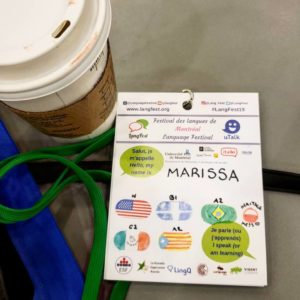
I failed out of high school Spanish. 11 years later, this was my name tag at Langfest 2019 with the languages I could speak at that time.
So is Spanish hard to learn?
I used to think Spanish would be hard to learn.
When I first picked up Duolingo myself in the winter of 2017, I thought it would take me years to even have a conversation. But I would do it with hard work and determination.
And I had proof that it was hard!
I had failed out of Spanish class in high school.
I had forgotten my own native language.
I didn’t know anyone who had learned a language successfully as an adult.
So surely, Spanish must not only be hard but all languages must be hard.
Well, I don’t think so anymore.
As with all new skills, it can feel daunting and overwhelming at first. It can be a struggle. Learning and growing can take a lot of hard work and a ton of patience.
But ultimately–and especially for English speakers–Spanish doesn’t have to be hard to learn.
Find yourself some good language resources. Find yourself a good teacher. Experiment with what works or doesn’t for you.
And don’t give up.
If you want to know anything else about if Spanish is hard or easy to learn, leave them in the comments so I can help clarify anything you need!
